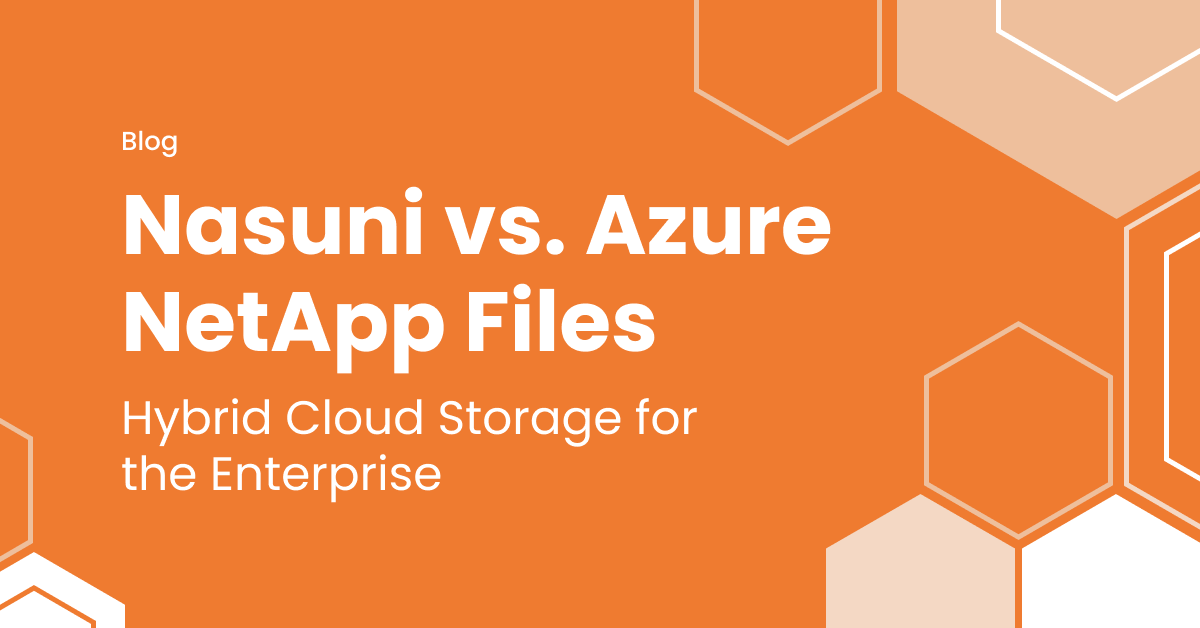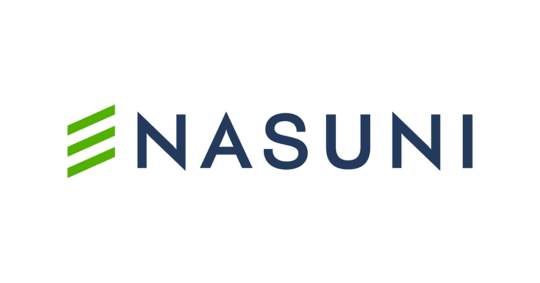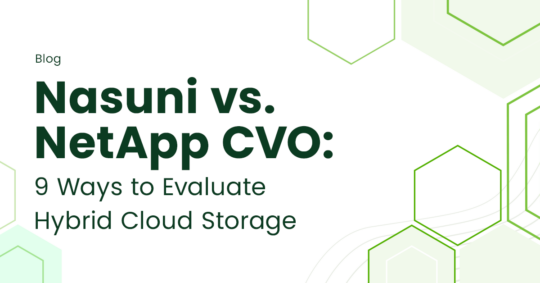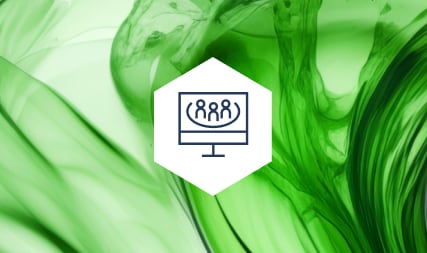Nasuni vs. Azure NetApp Files: Hybrid Cloud Storage for the Enterprise
Nasuni’s Ryan Wood returns to discuss the main differences between Nasuni and Azure NetApp Files.
May 22, 2025 | Ryan Wood

NetApp is undeniably one of the preeminent brands in storage. Yet what enterprises expect from a storage solution has changed profoundly in the era of hybrid cloud and artificial intelligence. A recognizable brand is not enough. Today, a storage solution must deliver unlimited scale in every dimension, fast performance at all sites, efficient collaboration between those locations, rapid recovery from ransomware attacks, and more.
The Nasuni File Data Platform and Azure NetApp Files (ANF) both leverage the cloud, but they do so in very different ways. Nasuni relies on unlimited, cost-effective cloud object storage, while Azure NetApp Files uses block-based storage arrays hosted in Azure. This important technical difference leads to two distinct solutions with differing capabilities.
Here are 12 ways to compare Nasuni and Azure NetApp Files.
1. Technology
Azure NetApp Files is a fully managed, highly available Microsoft service designed for high-performance, low-latency workloads. The solution is built on NetApp’s bare metal, with NetApp All-Flash FAS arrays (AFF) powered by the ONTAP storage operating system hosted in Azure datacenters. That is a mouthful, but the technology works very well for SAP HANA and Oracle applications that require advanced data management capabilities, enterprise web apps, and other workloads that are I/O-intensive but lower in terms of overall capacity. Yet this block-based architecture is fundamentally different from a cloud-native model and introduces cost and scalability challenges as environments grow.
This sensitivity to scale is one of the reasons the Nasuni File Data Platform is often recommended as a better choice for enterprise customers. Nasuni’s cloud-native file system resides fully in object storage from Azure, AWS, Google Cloud, or on-premise providers. Lightweight Nasuni Edge Appliances deployed in cloud regions or on-prem locations cache only active data locally to deliver LAN-speed access. Nasuni’s object-first approach allows for seamless file share scalability through a single, unified instance, and makes it possible for the Nasuni platform to deliver a long list of additional capabilities in addition to the functions of a traditional storage solution.
2. Scale
There is no need to define a maximum volume size at creation with Nasuni. Storage growth is elastic, and capacity is only limited by the backend cloud object storage and billing/account limits. There is no maximum file share capacity. No hard limit on file sizes. And you can easily add capacity on-demand.
In recent years, Azure NetApp Files (ANF) has been increasing its volume and file count limits, but resource limits remain. When those limits are reached, you need to create additional volumes, which in turn forces you to make decisions on how to divide data across these silos. Each of these volumes then requires its own administration console. A large global enterprise is therefore forced to continue working with silos of file data instead of a single unified global file system.
3. Locations
Scale is about more than expanding the total volume of data stored. A hybrid cloud storage solution should scale efficiently in every dimension, including the number of locations served and the number of users who can access the file share. Nasuni supports scalable deployment across any number of customer locations, with each Edge Appliance capable of supporting thousands of users accessing the same global file system. The caching Edge Appliances provide fast access to file data for local users, but each one syncs with the global file system, maintaining a single, unified namespace.
With ANF, your file data is locked into a single Azure region. Cross-region replication can be created for disaster recovery (DR) purposes, but you won’t be able to collaborate between the two volumes. Cross-region replication can double costs and does not support multi-site write use cases. We’ve found that this multi-site capability is essential for large companies or enterprises that facilitate collaboration between distant locations or need to support follow-the-sun collaborative workflows.
4. Global Locking
One of the first things we learned in deploying a global file sharing and collaboration solution was the importance of file locking. Version conflicts halt productivity. The Nasuni Global File Lock:
- Works across all Nasuni Edge Appliances (NEAs) accessing the same volume
- Ensures only one user – anywhere in the world – can modify a file at a time
- Orchestrates global file locking through the cloud, requiring no additional server purchases or administrative oversight
Azure NetApp Files doesn’t coordinate locks across sites. It doesn’t support multi-site write collaboration. ANF also has no mechanism to prevent version conflicts. ANF supports file-level locking at the protocol level (SMB/NFS). This is only local locking per volume, not global locking across multiple regions or instances. As a result, it’s not suited for a global, collaborative organization.
5. Global Acceleration
When files are updated, they need to be made quickly accessible across distributed teams. Azure NetApp Files offers no built-in global acceleration or edge caching, which means latency and sync delays can impact collaboration.
One major lesson we learned in working with some of the largest and most collaboration-driven organizations in the world is that the latest versions of files need to be available immediately. We developed Nasuni Global File Acceleration for exactly that purpose. The tool monitors file system audit logs, effectively learning which Nasuni Edges in which locations should receive new files first. This accelerates data propagation by up to 20X, ensuring distributed teams always have access to the most up-to-date content.
6. Multi-Cloud
Azure NetApp Files is — unsurprisingly — exclusive to Azure. This in itself is not a problem, as Microsoft Azure is a fantastic cloud provider. Nasuni, however, supports multi-cloud flexibility across Azure, AWS, Google Cloud, and even on-prem object stores like NetApp StorageGRID or Dell ECS.
Many of our customers choose Azure as their sole or primary cloud object storage backend. Yet many of them also want the freedom to rely on multiple clouds for economics, performance, regional availability, and data residency requirements. A single Nasuni Edge Appliance can present file shares from multiple clouds, enabling hybrid or multi-cloud strategies without adding any administrative burdens or fragmenting file access.
7. Backup
Azure NetApp Files has a limit on snapshots that has proven frustrating, expensive, or both for IT administrators at large companies. IT has to turn to 3rd party backup tools for long-term data protection and/or devote cycles to pruning snapshots to avoid hitting that snapshot ceiling. Nasuni stores snapshots as immutable objects on low-cost, durable cloud object storage. When our customers choose Azure Blob, they have as many as six air-gapped copies and improved RPOs and RTOs. Ultimately, our customers no longer need traditional backup solutions for their file data. They can eliminate these redundant solutions and realize major cost and time savings.
8. Cost
A simple comparison of the costs of the two solutions is difficult, as total cost of ownership is dependent on a variety of factors, including the particulars of your file data environment and business needs. Azure NetApp Files pricing is tied to performance tier (Standard, Premium, Ultra), capacity, Azure region, data egress, and snapshot usage. Costs can escalate quickly, especially when enabling cross-region replication or maintaining a hot DR instance in a second region.
Nasuni pricing depends on capacity, object storage type, and optional services. The total cost of each solution depends on your organization’s file data volume, number of locations, number of users, and business priorities, including ransomware preparedness. With no additional licensing needed for backup, disaster recovery, or file synchronization, and with edge caching done via software-defined VMs, customers typically reduce total cost of ownership (TCO) by up to 65% compared to traditional storage stacks or ANF-like solutions.
9. Ransomware
The cloud-centric Nasuni file system functions as a pointer, so in the event of a ransomware attack, recovering files is simply a matter of redirecting the pointer to an earlier snapshot. No massive movement of data is required, so petabytes of capacity and millions of files can be restored in seconds. Additionally, Nasuni’s integrated Ransomware Protection detects attack signatures at the edge, triggers automated remediation, and limits damage by restoring only affected files.
With Azure NetApp Files, data must be physically moved from snapshots or 3rd party backup systems after a ransomware attack, a process that can take hours.
10. Disaster Recovery
If the primary instance in an Azure region becomes unavailable due to a disaster, an Azure NetApp Files customer will need to cut over to a second DR instance in another Azure region. This second instance must be ready on standby for such an event. This approach can work, in the sense that access is eventually restored, but maintaining this second instance with cross-region replication drives up the cost significantly.
Nasuni’s disaster recovery model is stateless and instantaneous. If one location or Edge Appliance fails, a new Edge can be provisioned and rehydrated either in a safe location or in the cloud within 15 minutes — no backup restores, no data movement, no extra licensing.
11. Management
IT teams work through the single-pane-of-glass Nasuni Management Console to provision, configure, monitor, and manage all components of the Nasuni File Data Platform across all locations — from snapshot policies to ransomware alerts to user access reporting —without extra tools. One unified platform, one console.
Managing multiple ANF volumes across regions and use cases often requires multiple consoles, especially when layering in 3rd-party tools for backup, DR, ransomware protection, and data intelligence.
12. Data Intelligence & AI
As both Nasuni and NetApp are expanding their data intelligence solutions, comparing how the two solutions meet the needs of the modern global enterprise today may change tomorrow. What will not change is the availability of file data. NetApp offers separate solutions like BlueXP Classification for data visibility, but ANF itself lacks integrated data intelligence or usage analytics. The result is siloed file data that’s harder to curate for AI readiness.
The unified cloud-centric architecture of Nasuni’s hybrid cloud storage solution makes it easier for enterprises to manage and curate all global file data. Our data intelligence and analytics tool, Nasuni IQ, is designed to support the use of AI tools and services, as it gives organizations detailed insights into global file data usage. This enhanced data intelligence sets up organizations to get more out of the AI tools of today and tomorrow.
What’s Right for You?
Both the Nasuni File Data Platform and Azure NetApp Files offer hybrid cloud storage solutions, but they differ significantly in architecture, scalability, and enterprise readiness.
If your organization is running I/O-intensive workloads like SAP HANA, databases, or legacy enterprise apps that require block storage performance in Azure, then Azure NetApp Files may be a fit. However, for general-purpose file data, ANF’s scalability limitations, lack of file collaboration features, and high cost can be a barrier.
For organizations looking to consolidate Windows File Servers, NetApp, or Dell Isilon SMB/NFS workloads, or support hybrid collaboration across distributed teams, Nasuni will be the optimal choice. Nasuni runs on top of scalable cloud object storage like Azure Blob, giving your organization a cost-effective, scalable, easy-to-manage solution with built-in security, rapid ransomware recovery, global file locking, and fast edge performance at all locations – all in a single unified platform.
Finally, we are making it easier than ever to move to Nasuni. Our Professional Services offerings include tools to accelerate migration, retain permissions and ACLs, reconcile orphaned SIDs, and more. Want to learn more? Reach out to a Nasuni representative today.
Related resources

Nasuni vs. NetApp
Comparing Nasuni vs. NetApp? Nasuni consolidates your data in a global file system for easy collaboration, management, and AI.
Learn more
April 02, 2025 | Ryan Wood
Nasuni vs. NetApp CVO: 9 Ways to Evaluate Hybrid Cloud Storage
Nasuni’s Ryan Wood shares his insights on Nasuni vs. NetApp, outlining key differences between the platforms.
Read more
Webinar
Navigating the Azure Cloud Waters for File Storage
Learn more about: why leading companies are moving to cloud file storage in Azure, the differences between Azure Files, Azure NetApp Files, and Azure Blob…
Learn more